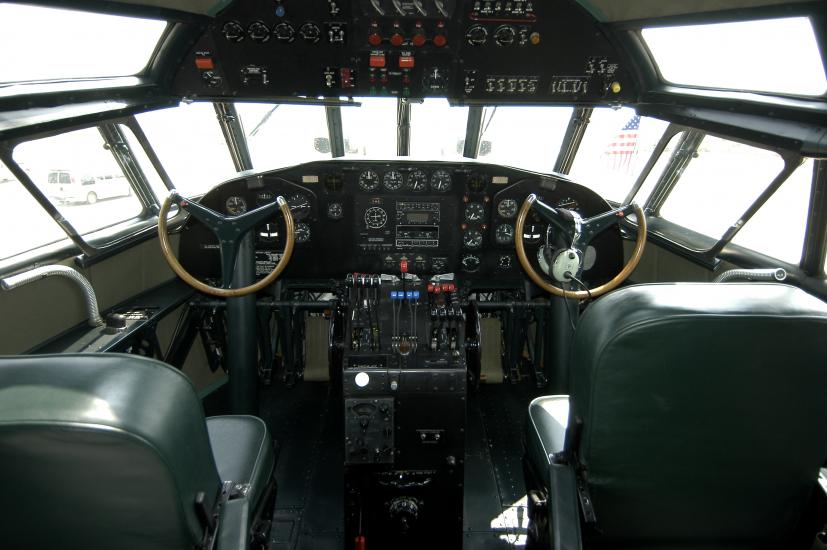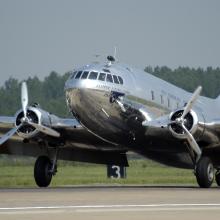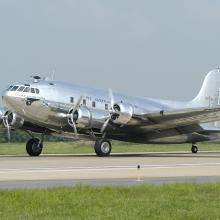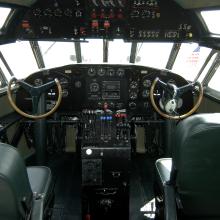
Media Inquiries
Public Inquiries
The Smithsonian's National Air and Space Museum welcomed today (Aug. 6) the sole surviving Boeing S-307 Stratoliner to its new home when the silver pioneering airliner arrived at Washington Dulles International Airport in Virginia for display at the museum's new Steven F. Udvar-Hazy Center. The museum's companion facility, adjacent to the airport, opens to the public Dec. 15.
The luxuriously appointed Stratoliner, built in the late 1930s, was the world's first passenger airplane to be pressurized, allowing it to avoid rough weather by flying at unprecedented altitudes (20,000 feet) for transports of the era.
The airplane has been in the museum's collection since 1972 but because of its size and weight could not be displayed at the museum's flagship building on the National Mall. A team of volunteers and Boeing staff performed extensive restoration work on the airplane in Seattle.
"Visitors to the Udvar-Hazy Center will take one look at this airplane and be transported back to a glamorous age when the world became smaller for the traveler who required speed and luxury," said Gen. J.R. "Jack" Dailey, director of the National Air and Space Museum. "We are indebted to the Boeing restoration team for turning back the clock on this beautiful aircraft."
The Stratoliner arrived in Northern Virginia following an appearance at the Experimental Aircraft Association's annual Fly-In at Oshkosh, Wisc. The airplane flew from Allegheny County Airport near Pittsburgh, where it landed August 5th because of bad weather.
With a wingspan of 107 feet and a cabin nearly 12 feet wide, the Clipper Flying Cloud will be exhibited at ground level in the Udvar-Hazy (pronounced OOD-var HAH-zee) Center aviation hangar.
More than 200 aircraft are ultimately destined for the aviation hangar, which is 10 stories high and the length of three football fields--enough space to hold the museum's building on the National Mall inside with room to spare.
The center will eventually display the 80 percent of the national air and space collection not currently housed at the building on the Mall or on loan to other museums and institutions.
Smaller aircraft at the center will hang at two levels from the aviation hangar's trusses. Rising walkways will allow visitors to see the suspended aircraft up close and give them a sense of soaring.
The Clipper Flying Cloud was delivered to Pan American Airways with two others in 1940. The aircraft carried 33 passengers and a crew of five. The Pan American Airways airplane was reconfigured to seat 45 passengers. Stratoliners included space for berths for overnight travel; paneling in the cabin and lavatory; wall fabric featuring the Pan Am logo, world map and exotic animals; and eight divans.
The Clipper Flying Cloud began service flying Caribbean routes for two years. During World War II, it flew in South America under the direction of the U.S. Army Air Forces. In 1946, it made daily runs between New York and Bermuda. Throughout the next two decades it passed through the hands of several owners, and once served as a presidential plane for the notorious Haitian leader "Papa Doc" Duvalier. After its Haitian sojourn, the Clipper Flying Cloud landed in Arizona.
In 1969, a visiting National Air and Space Museum curator spotted the airplane in Arizona and immediately recognized its historic significance, even while its then-owner planned to convert it into a fire bomber. The Smithsonian subsequently acquired the aircraft and later made arrangements with the Boeing Company for the restoration, dubbed "Operation Flying Cloud," at the Seattle plant where the Stratoliner was originally built.
Boeing technicians and former Pan American employees voluntarily spent six years completely restoring the Stratoliner before it made an emergency landing in Elliott Bay in 2002. Since then, the restoration team has performed additional work so that visitors to the Udvar-Hazy Center will have the opportunity to view the aircraft as it looked the day it rolled off the assembly line more than 60 years ago.
Artifact and exhibit-related deliveries to the center continue on an almost daily basis leading up to the December opening when some 80 aircraft will be in place - more than are currently displayed at the Mall building. Many have been dismantled because of their size and must travel in pieces. Those aircraft are being reassembled in the hangar and moved to their display locations. After the Udvar-Hazy Center opens, deliveries will resume early next year at a slower pace and continue until the facility is full.
The first construction phase of the center also includes the James S. McDonnell Space Hangar, named for the aerospace pioneer; the 164-foot-tall Donald D. Engen Observation Tower, named for the museum's late director; the Claude Moore Education Center, named for the Virginia philanthropist; an IMAX theater; and a food court.
Construction work continues on the McDonnell Space Hangar, which will house America's first space shuttle, Enterprise. The space hangar will be completed by opening day with the Enterprise installed and visible; however, the structure will not be accessible to the public until 2004 as Enterprise undergoes restoration. During the interim, some 50 large space artifacts will be previewed in the aviation hangar. The space hangar will ultimately house some 135 large space artifacts.
Thousands of smaller objects from the museum's collection will also be displayed throughout the Udvar-Hazy Center in customized cases, many adjacent to exhibit stations that will provide historical context through graphics and text.
A second phase of construction for the Udvar-Hazy Center - including a restoration facility, an archival resource center, a conservation lab, a collections processing facility and a study collections storage unit - is planned, with the start date for construction dependent on fund raising. The entire facility will be approximately 760,000 square feet. No federal funds are being used to build the Udvar-Hazy Center.
The National Air and Space Museum, comprised of the Udvar-Hazy Center and the museum's building on the National Mall, will be the largest air and space museum complex in the world. The flagship building is the most popular museum in the world, attracting more than 9 million visitors each year. Attendance at the Udvar-Hazy Center is projected at 3 million people a year.





